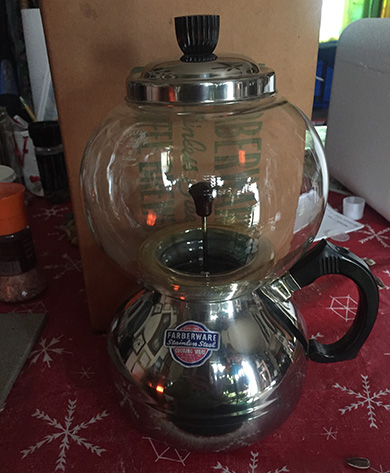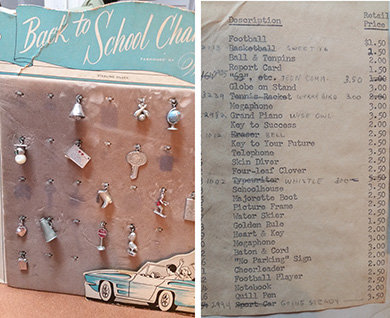 |
|
|||
 |
 |
|||
Copyright © Harry Rinker, LLC 2017 Questions
and Answers
QUESTION: I have a Model 748, eight-cup Farberware stainless steel coffee brewer. The stainless steel pot has a period Farberware sticker. Dunbar made the heat resistant glass top. The stainless steel top cap has a fluted cup-like finial. I tried searching the internet for information but found none. Any idea as to whether it is useable and its value? – BR, Ronkonkoma, NY, Email Question 
ANSWER: Since your Faberware coffee brewer is “new in the box,” there is no question that it can be used. Your brewer is a vacuum percolator, the predecessor to the automatic drip percolators that followed. It was a common method used to make coffee in 1920s and 1930s diners, kitchens, and lunch wagons. Water is boiled in the lower half. As it starts to steam, the upper glass section is inserted. The expanding steams pushes the water through a filter and into the upper unit, which holds the coffee. After a minute or so, the unit is removed from the heat. As the steam cools, a vacuum is created, drawing the freshly brewed coffee back through the filter and into the lower pot. The top is removed to create a pot of freshly brewed coffee. [For a detailed description on how the process works, see: http://coffeecompanion.com/2011/10/corey-vacuum-brewer/] A number of American household manufacturers, such as Corey, Corning, Dunbar, Silex, and S. W. Farber, made vacuum coffee brewers. Brian Harris, Westford, Massachusetts, created http://coffeecompanion.com/2011/10/corey-vacuum-brewer/, a comprehensive website on the history of the vacuum coffee brewer. I emailed Brian to ask his help in identifying your specific Farberware coffee brewer. He responded: “What an interesting vacuum coffee maker…. Farberware manufactured a line of innovative and unique coffee makers they called ‘Coffee Robots,’ which were introduced in the mid-1930s….Your vacuum pot is a follow-on to that line and appears to be their last vacuum pot made before switching over to the pumping percolator technology. I have located the design patent….It was filed in 1942….It is interesting that your glass is marked ‘Dunbar.’ On the older ‘robots,’ the glass was unmarked. I do not doubt that the glass is period. Farberware presumably had an arrangement with Dunbar Glass Company to supply the upper globes. Dunbar also sold their own brand of all-glass vacuum coffee makers.” eBay sellers are asking prices ranging from $30.00 to $50.00 for comparable vacuum coffee makers. Sell through prices on WorthPoint.com suggest a price range between $20.00 and $35.00. Given the near mint condition and history behind your Model 748, its value to a vacuum coffee brewer collector is between $40.00 and $50.00. QUESTION: I have a 1950s Wells “Back to School Charms” window display card that retains 14 of the charms. In 1952, my parents started the jewelry store in which the display card was used. The color is faded somewhat because the card was displayed in the window. The back contains a list of the initial Sterling Silver charms found on the display card. As charms were sold, they were crossed off and replaced with other charms. The cost per charm varied from $1.50 to $3.50. A few examples are: Cheerleader ($2.00), Football ($1.50), Four Leaf Clover ($2.50), Globe on Stand ($3.00), Majorette Boot ($2.50), Report Card ($1.50), and Telephone ($3.50). What is the value and where might I sell my Wells display card with its remaining charms? – LS, Reading, PA, Email Question 
ANSWER: I was a young adolescent during the late 1940s and 1950s charm bracelet craze. School girls created silver charm bracelets. Mothers and grandmothers usually had gold charm bracelets, with charms ranging from 10K to 14K. Your display card with its charms is a reminder that sterling silver was often used in costume jewelry in the mid-20th century. In an era when a Coke was a nickel and a Saturday matinee a quarter or less, spending $1.50 to $3.50 for a charm was a serious investment for a young person. The website www.925-1000.com/americansilver_W2.html notes: “Wells, Inc., Attleboro, Massachusetts. Active 1922-1978, founded by Raymond L. Wells, jewelry manufacturer, primarily bracelet charms in sterling and some in enamel. Wells acquired the firm of R. Blackinton & Co. in 1967 and, in 1977, they were combined with Benrus. Jewelry manufacture ceased in 1978.” Attleboro, Massachusetts was once known as the “The Jewelry Capital of the World,” because L. G. Balfour Company, Guyot Brothers, and many other jewelry and jewelry support manufacturers were located there. Balfour eventually moved its operations to Texas. Although several jewelry and findings manufacturers still are located in Attleboro, it no longer claims the “Capital” title. Wells Sterling Silver charms are eagerly sought by collectors. Average prices on Rubylane.com range between $18.00 to $24.00. Sell through prices on WorthPoint.com suggest a range of $13.50 to $18.00. Hard to find themed charms can exceed $30.00. Assuming a conservative secondary market retail value of $12.00 per charm, your 14 charms have a value of $168.00 dollars. Add another $50.00 minimum for the display card. A fair secondary market value for your Wells Sterling Silver charm display card and charms is between $225.00 and $250.00. eBay is my first choice to sell the display card. If you know someone who has a store front on Rubylane.com, this is a possibility. I do not have enough experience with Esty.com to suggest it. Avoid Craigslist or a local auction. The display card needs national exposure to achieve maximum value. QUESTION: I have a blue Dugan ear of corn vase. When I take a flash picture, the top half glows. It appears blue in ordinary light. Any idea what it is worth? – BH, Email Question 
ANSWER: Northwood, Dugan, and L. G. Wright manufactured pressed glass ear of corn vases. Collectors, especially neophyte collectors, often confuse them. The Northwood vase is shaped like an extended tumbler and has a flat rim. It comes in two basic variations: (1) plain and (2) leaves, sometimes referred to as stalks. The Dugan opalescent ear of corn vase has an extended full corn body, curved dip at the top, and openings between the twisted sections of husk. The L. G. Wright copy of the Dugan ear of corn vase has a flat top and no openings between the twisted sections of husks. [For more detailed information between the Dugan and L. G. Wright ear of corn vases, see: http://www.ebay.com/gds/Corn-Vases-Dugan-Originals-and-Wright-Reproductions-/10000000003197420/g.html] The period Dugan ear of corn vase is found in four opalescent colors – white, canary (vaseline yellow), blue, and green. L. G. Wright (New Martinsville, West Virginia) issued their opalescent examples in amber, light blue, blue, and yellow vaseline. When L. G. Wright dissolved, many of its molds went to China, meaning that the L. G. Wright ear of corn vase may appear in additional colors. Some unscrupulous sellers have chipped out the glass between the body and stalks of the L. G. Wright ear of corn vases in order to pass them as Dugan. The opalescent on your vase may not be easily visible when viewed with regular light. The flash of your camera makes it come alive. The secondary market value of your vase is between $150.00 and $175.00. QUESTION: I have a round brass disk, the back of which has two round half-round clips. I believe it is a chimney blocker. Our house was built in the early 1940s. During a remolding project in the early 1970s, I found the disk. The disk has three sections – the first a fluted ring, the second a flat ring, and the third two small tiers of geometric designs. The center features a sepia picture, the tone possibly coming from dirt, of a country landscape of rolling hills and a few buildings. What can you tell me about this? – BG, Reading, PA 
ANSWER: You have a “flue cover.” In homes without central heating, heating was provided by parlor stoves. These were set in place in the fall and then taken out in the spring. The stoves had to be vented. When the stove and its flue pipe were removed, a hole in the wall remained. These holes led to the creation of flue covers. Flue covers were mass-produced as well as homemade. There were dozens of variations -- brass or glass, square, rectangle, or oval, and an endless number of picture possibilities. Your example is common. Examples listed on eBay have asking prices ranging from $4.00 to $10.00. Harry L. Rinker welcomes questions from readers about
collectibles, those mass-produced items from the twentieth and twenty-first centuries.
Selected letters will be answered in this column.
Harry cannot provide personal answers.
Photos and other material submitted cannot be
returned.
Send your questions to: Rinker on Collectibles, 5955 Mill
Point Court SE, Kentwood, MI 49512.
You also can e-mail your questions to
harrylrinker@aol.com.
Only e-mails containing a full name and mailing address
will be considered.
You can listen
and participate in
WHATCHA GOT?, Harry’s
antiques and collectibles radio call-in show, on Sunday mornings between 8:00 AM
and 10:00 AM Eastern Time.
If you
cannot find it on a station in your area,
WHATCHA GOT?
streams live on the Internet at www.gcnlive.com.
SELL, KEEP OR TOSS?: HOW TO DOWNSIZE A HOME,
SETTLE AN ESTATE, AND APPRAISE PERSONAL PROPERTY
(House of Collectibles, an imprint of Random House Information Group, $17.99),
Harry’s latest book, is available at your favorite bookstore and via
www.harryrinker.com.
|
||||